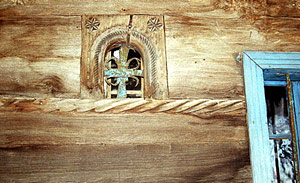Sarbi Susani Church

Year built: 1667
Location: Sârbi is situated in the valley of the Cosău River, 27 km south of Sighetu Marmaţiei, between the equally famous villages of Călineşti and Budeşti.
Summary: The small size of the church, the very thick oak beams of the walls, the unitary roof covering the whole building, the rather short tower, the very small and windowless pronaos, and the iconostasis with only two, not three, doors are all signs of a church built before the 18th century.

The entrance to the church is on the south façade. An extremely rich carved decoration on the wide frame of the door is similar to the one in Bude[ti Josani. A thick twisted rope goes around the door and curls at both ends, by the floor. Three intricate big crosses are on the lintel and on both jambs, and all the surfaces are carved with rosettes, triangles and wolf’s fangs. The door itself is simple, a panel of wide planks hung on wooden hinges.
A carved twisted rope decoration goes around the church at eye and window level. The consoles that support the roof cross each other at the east apse. They are carved with a stepped profile. There is no porch, but benches line all exterior walls under the wide eaves.
The original mural painting was applied on pieces of textile that were covered with a preparatory layer of limewash and attached to the wooden beams of the walls.

The paintings on the walls of the pronaos were removed at some point and the pieces of textile were stored in the attic of the church. They have since then been put back on the walls, but are not in very good condition. The inscriptions are all in Slavonic, which indicates that the paintings are among the oldest in Maramures.
The east face of the iconostasis has an inscription in Romanian with Cyrillic letters “This holy altar was painted in the year 1800 left by God the month of May, the 1st, Ştefan Amokevici”. In the lower part, there is the portrait of St. Zosima in a monk’s cowl and an open book in his hand.



